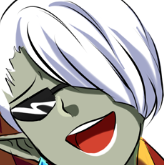|
|
Post by Lyrikitty on Jan 2, 2009 23:23:35 GMT -5
There are a few pets on Pern that are not found in the books, or elsewhere. Below will be posted the information of each, as they are made and accepted.
|
|
|
|
Post by Lyrikitty on Jan 2, 2009 23:24:40 GMT -5
These creatures are palm-sized, not large at all, and have been known by many names, though the official one is myrr. They are relatively intelligent, more so than a Runner or a flit, but not so much as a dragon. Unlike dragons and firelizards, they are not segregated into classes of rank, such as queen, king, or any of the like, as any female may breed, and any male may breed. Females do not clutch, but birth live offspring, up to three at a time, though of the three, only one will generally survive to adulthood, even if they are all cared for by a master. Despite their appearance, which is rather intimidating for all their size, myrr are mostly affectionate creatures, very loving to those they trust and those who care for them, and protective. Many residents of the North Continent, once the myrrs were discovered, use them for baby-sitters, as the little creatures are able to follow a child almost anywhere, and will allow no harm to come to the child. Like dragons, firelizards, and even whers, they are able to Between. For a myrr to Between, as they cannot fly, is odd, though entirely possible. Their thick, powerful rear legs allow them to jump high enough into the air to safely Between though they must have their destination in mind before they jump. A very rare few have managed to cultivate speech, and can communicate with anyone (it seems that the Jewels are the most capable of this). Most, however, simply use an odd sort of telepathy, not speaking, but rather, placing thoughts in the minds of others. Like firelizards they do not have to have a human to survive, they are able to be wild or tamed, though the wild myrr enjoy staying close to the Weyr, often in the darker, lesser visited areas. The wings of a myrr are not for flight, they are too small and cannot support the body, but for intimidation and for courting, like many creatures, the males will try and attract females to them by dancing and displaying themselves, some even making an odd sound that is remarkably like humming.
Myrr are not native to Pern, but like the dragons and whers, they are products of experiments. Where their dragon cousins have grown larger over the turns, the myrr have become smaller, and are now at their goal size. Originally, they were the size of a smallish runner, and used as mounts, for some times. But as the humans of Pern migrated to the North, most of the myrr were left behind, and unknowing how to survive trhey died off. Only those who were taken North lived, and continued, though within fifty turns of the crossing, the myrr vanished.what happened is unsure, for though they had been slowly shrinking in size, they were still relatively large at the time, and it was hard to imagine a creature such as they simply disappearing. However, ten turns ago, a myrr was found, at the palm-sized vesion they are now, in the depths of Crystal Cavern.
The official colors of the myrr are as follows:
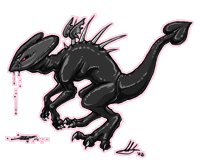 Black Black
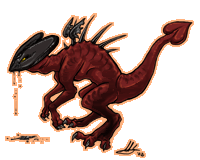 Red Red
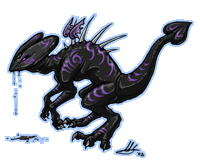 Jewel Jewel
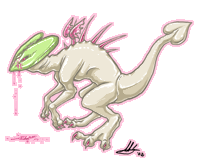 White White
**Myrs can only be found in the North Continent. They are not found elsewhere, and will not be pets for elsewhere.**
|
|
|
|
Post by Desert on May 29, 2009 15:41:09 GMT -5
credit for the concept goes solely to Onyx
Cion:
Cion are a distant, ancient species of tunnel snake that has only recently been discovered; it has no record all throughout Pern's history. Perhaps this is because they thrive on the Eastern Continent and it has only been colonized within the last few decades, remaining relatively unexplored. Or, perhaps the habitat of these snake like creatures is the reason for their only recent discovery. These softly scaled creatures dwell in and among heavy deposits of volcanic ash, deep in the bowels of both dormant and active volcanoes. Their hides are designed to withstand both enormous pressure from the ever shifting walls around them, frequent cave-ins, and temperatures from the festering bowels below. It is unclear whether or not they can survive a quick swim through cooling magma or not, but it isn't too hard to believe such possible because their ever shifting environment both above and below could call for it at any point in time. Along their serpentine like bodies, several adaptations have come into play to help them thrive and remain relatively undetected for all these years. For starters, they're terribly agile; catching one is beyond impossible as they are designed to slide back and forth across sand like surfaces or even water with grace and ease and, even on land, their flexibility allows them to dive into the smallest of holes to escape being apprehended. As if this wasn't enough, Cion have six fin like appendages along their bodies designed to help them climb up rocky surfaces as well as trees. These sticky fins resemble a Terran fish's, but function as a gecko's. Though, they do not always jut out as a normal arm or leg would, as they would only get in the way. To compensate, these fins fold against the animal's sides and back, only unfurling when climbing is necessary to escape predators and such. Those 'fins' on top are not sticky in any fashion, and are the remnants of wings; utterly useless aside from their use for helping to clear out their burrows and prepare nests. Their mouths are designed like a dragon's, maw-like, with four fangs in all that fold back along the soft palate as a serpent's does. All Cion follow this general body structure, but there are further categories that they break down into for appearance. These are Alpha, Beta, Gamma, and Omega. We'll start at the lowest on the list:
Most Cion are born with the Omega coloring; that is to say a stone colored body gray with gray-black fins and no other defining markings. With this coloring comes a very specific behavioral pattern, as with the other categories. Basic. That would be an apt term to describe the mindset of these types of Cion. They seek out nothing but what they alone need to survive and operate in a pack system known as swarms; you will never find an Omega Cion alone. As a whole, these Cion are very selfish and the most violent of their coloring, liable to snap and swarm anything they deem a threat. For this reason, you won't find many domestic Omega Cion around humans and, if you do, the owner won't jut have one but up to three to ensure their health. They're cowards and so heavily dependent on their groups that separation from them is a death sentence. Omega Cion have no skill where communication is concerned and this further makes them unrealistic choices for pets. Ironically though, they are the most obedient of their species, and accept leadership from their Beta parents or a roaming Alpha without question. When their Beta parents leave them, they'll work as a unit with no one Omega above the other, and this doesn't change until the members of the swarm start to die off. These Cion live the least of all because, if one falls ill and dies of sickness of injury, the entire group suffers a form of depression that eventually takes the group out. They are capable of reproducing, but more often than not their clutches die from lack of proper care.
The second most common is the Gamma coloring. These Cion are a dark, almost blood red in hue with dark specks of black around the edges of their scales. Unlike the basic Omega Cion, these guys have a longer body structure and thicker build, and operate less in a pack mentality. They are more intelligent than their gray brothers and sister, but lack a genuine grasp of most things and they have a tendency to be particularly ADD. They are not anywhere near as aggressive, and in fact delight in playful games, and are perhaps the most curious of their species. Many Cion pets come from this coloring particularly for these reasons. Much like their Omega brothers and sisters, they can reproduce but their attention spans do not make them the most doting of mothers or watchful of fathers. As a result, Gamma Cion will flirt and flit around for mates but their clutches rarely ever survive.
The third is the Beta coloring. These Cion are a deep, ebony shade coating the entire of the body with flecks of silver around the edges of the scales. Unlike the Omega and Gamma, these Cion have a further distinctive marking, and that is the cone structure to their skulls. It's an elongated skull cap that could almost be classified as a horn if one did not take a closer look at them. This is a defense mechanism, used mainly for scaring off predators because, when threatened, these Cion brace themselves on their four fin like limbs and sway their skull around, lunging out as if to strike at their opposition, though the nurturing nature of these Cion would not allow for much violence unless provoked first. These are the breeders of their kind, and the most commonly found leading the groups of Omega about because they tend to be their own younglings. They are rather protective, but tend to separate away from their clutches after their first year to find another mate. During these separation points, those first three weeks or so after the Beta parents wean themselves from their young, it isn't impossible to assume that the reason they find a human is for a more stable being to care for. They, too, lack good communication skills, but are more inclined to learn than their Omega and Gamma brothers and sisters. As such, with repeated practice, they can be trained like a canine to perform simple tasks like fetch something small or guarding an infant's crib. They are ideal for such things, and affectionate companions. Or, at least it is assumed they are affectionate. After all, it's hard to tell how an unblinking creature feels.
Beta Cion, unlike Omegas, break away from their clutchmothers and fathers shortly after birth to seek out mates and create swarms of their own. This is because the pack lifestyle is not suited for these Cion unless they are nurturing their own, and staying in a swarm they were born to prevents them from reproducing.
Lastly, there are the Alpha. These Cion are the most distinguished and rarest of their grouping, and for a fair few good reasons. But, before getting to their personalities and such, their coloration and appearance is far different from the others. Cion of the Alpha classification are a pure, snow white and, just like a Beta, they have silver outlining their scales along with an elongated skull cap. Unlike a Beta or Omega though, these Cion have what would appear to be single whiskers beginning at the base of their lower jaws and extending as 'feelers'. They are equally as flexible as the rest of the Cion's body and twitch in direction according to command. They serve no real purpose aside from intimidation, and it's a pretty fair reason for why these Cion are the leaders of their swarms. They can command any other Cion under them without question, and often take charge over newly abandoned Omega swarms. Their rank in the grand scheme of things is to make sure as many survive as possible, so it goes without saying they pass from one swarm to another quickly, giving only the necessary guidance before leaving them as their parents did. They are the most likely of their kind to find a human as an owner, because they are natural loners. Their coloration is their biggest weakness as they would be about as common as Betas are, but are too easily picked out by predators for their white hue. With this in mind, they hide themselves away more, coming out only to find a mate occasionally, abandon the Beta female to her clutch, and then later return to make certain most of their younglings live past their first year. They aren't generally aggressive, but are quite violent when pushed, even more so than Omegas because they aren't so destructive in a group; any damage done is all their own. It goes without saying they are the smartest of their kind, but still lack the intelligence for communicating thoughts to their owners. This enhanced intelligence only shows in the fact they are the easiest to train, and quite loyal with no real reason behind it.
Cion do not Impress as dragons do to their owners, as Betas are terribly secretive about their clutches and hide them from anyone and anything with their partners. They'll disappear for weeks on end to tend to their little ones hatched from eggs, and wont return until they have to abandon them for the best. Even a 'trained' Alpha will stray away to tend to its young if it has sired a clutch. They are not advised as pets for this reason, but, owners have learned to cope with these behaviors. or, they have to deal with them, because any Cion will return to their owner once these instincts are sated. They imprint on one human, the first they come into contact with, and unknowingly trust them to impressive degrees. They DO NOT communicate to their owner through either images as a flit or through conversation as a dragon, and not even to the extent of a wher with feeling.
Obviously, Cion are found only in the Eastern Continent, and are the easiest to find in and around Solainoti Weyr.
|
|


